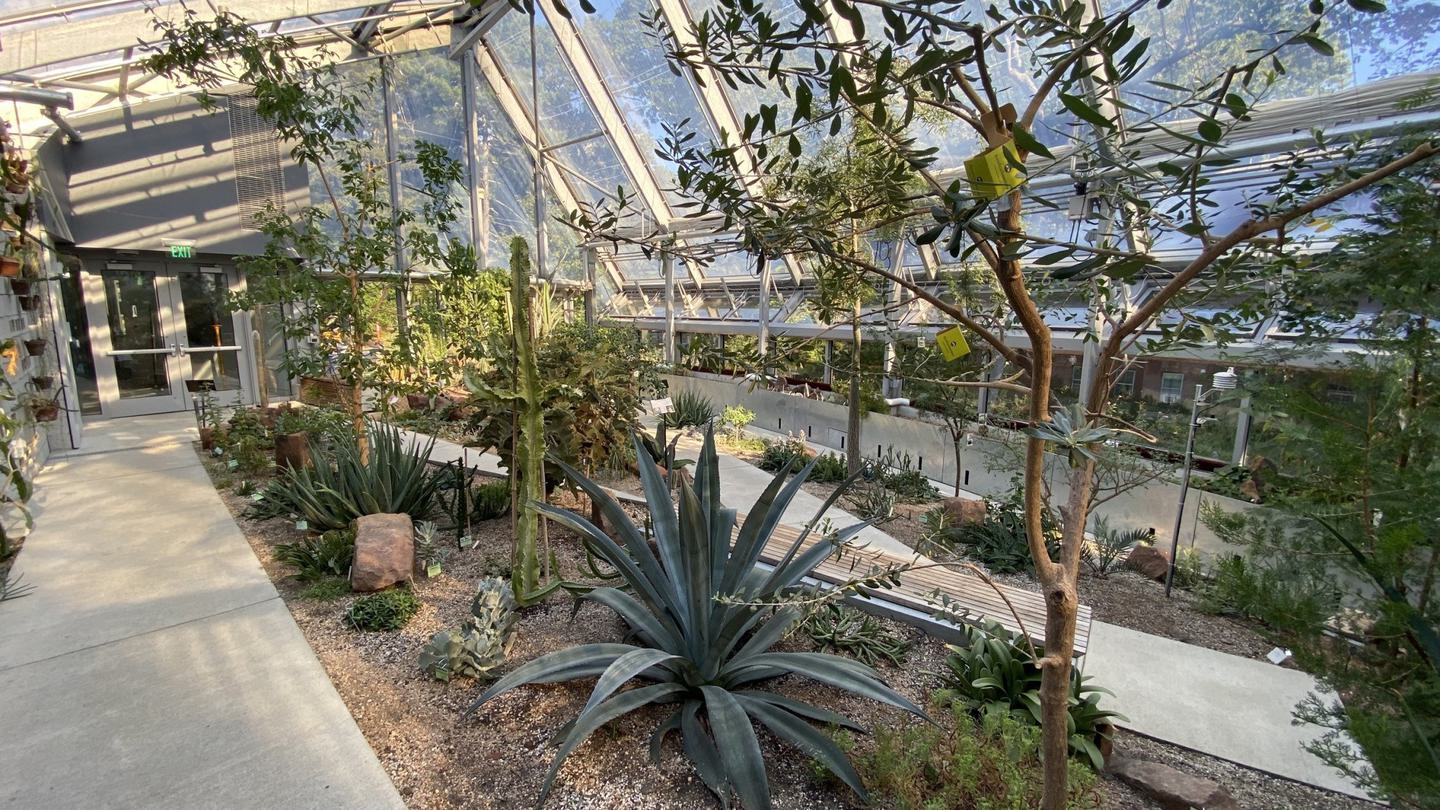The Global Flora conservatory brings together a diversity of plant forms and cultural connections in a connected landscape, representing plants from every continent except Antarctica. Beyond replacing an aging structure, the Global Flora project models innovative sustainable design, creates a new interdisciplinary platform for teaching and research, and provides a home for educational exhibits and interpretation that interweave the arts and sciences.
Global Flora includes three section - the Camellia Pavilion, which houses the Durant Camellia tree, a living link to the founders of the College who cultivated this specimen; the Dry Biome, which includes plants adapted to desert and dry climates around the world, and the Wet Biome, for plants from subtropical humid regions. The Mezzanine holds a seating area with a piano, and the Link is an art exhibit area that connects the Visitor Center and Global Flora. Several aquatic features within the greenhouse provide unique habitats and opportunities for study - learn more about the Mangrove, the Paludarium, and the live-streaming Sensor Network which monitors environmental data.
Built in 2019, the Global Flora conservatory houses plants for the public and campus to engage with directly, along with the small 1920's Annex greenhouse, which are part of the Margaret C. Ferguson greenhouse complex. The third set of greenhouses, the Teaching and Research Greenhouses, are for campus use only, and integrated into the newly renovated Science Center, all adjacent to the WCBG Visitor Center and Frost Center for the Environment.
Press highlights
US Building of the Week: Global Flora (World Architects feature) Interview describing the vision and architectural innovations of Global Flora
Wellesley's New Global Flora Greenhouse Wins International Sustainable Design Award < update link >
LafargeHolcim Foundation - prizewinning projects in sustainable construction
A Party to Connect People to Plants; Slipping Away to Global Flora; Going, Going, Gone; and Plant Health Team, Spring 2020 Thorndike Intern Yuxi Xia describes the first Greenhouse Light Show in Global Flora, Rob Nicholson gives an overview of the slipper orchid collection, Rob and Curation Assistant Annalise Michaelson discuss the rare and endangered plants in Global Flora, and the the work of the Plant Health Care Team is highlighted.
Road Trip! and Where the Weird Plants Are, Fall 2019 Botanic Gardens Director Kristina Jones and Botanical Collections Manager Rob Nicholson went on a collecting trip for Global Flora: Assistant Director Gail Kahn describes the plants in Global Flora's Ancient Corner.
Bones, Spring 2019 Rob Nicholson describes the hardscape features -- the "bones" -- being installed in Global Flora.
Global Flora: How to Curate a Collection, Fall 2018 Rob Nicholson writes about his goals and his process for putting together a new conservatory collection.
Visualizing Global Flora, Spring 2018 Explains many design details including the data collection network and the use of ETFE film instead of glass.
The Global Flora Project: Greenhouse Trees on the Move, Fall 2017 The large, landscaped trees in the Ferguson Greenhouses were dug up and moved to temporary homes during the summer of 2017.
Global Flora: Greenhouse Renewal, A Progress Report, Spring 2015 Kristina Jones describes the overarching theme of Global Flora and reports on the delay in starting construction.
Global Flora: Greenhouse Renewal, Phase 1, Fall 2014 The new greenhouse project - which we have dubbed the Global Flora Collection of the Margaret C. Ferguson Greenhouses - receives full funding. Kennedy & Violich Architecture works on a sustainable design, and Andropogon Associates will collaborate on the indoor landscapes.
Overview of the Global Flora project Botanic Gardens Director Kristina Jones describes her vision for an innovative new conservatory at Wellesley College.
